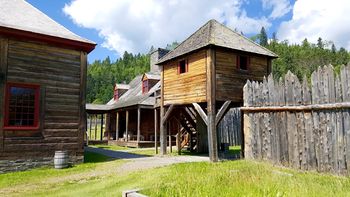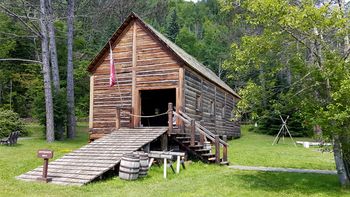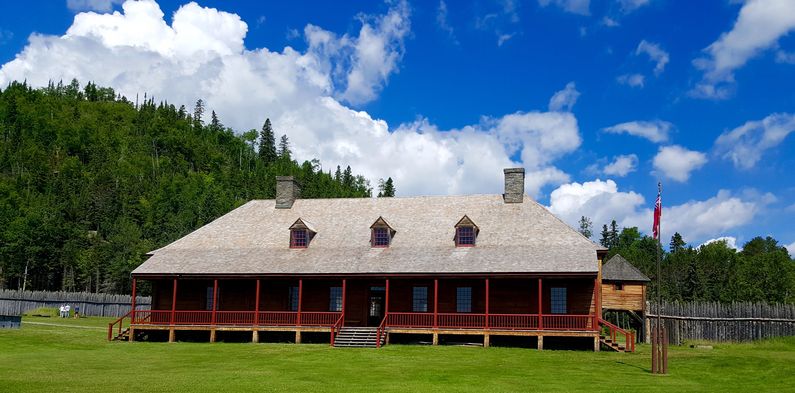Grand Portage Post
|
Grand Portage Post (1784-1803) - A North West Company fur trading post and storage depot established in 1784 on Lake Superior at Grand Portage Bay, Cook County, Minnesota. Abandoned in 1803 and removed to Fort William at present day Thunder Bay, Ontario Canada. Also known as Grand Portage Stockade.
Grand Portage PostEstablished in 1784 by the newly formed North West Company (NWC) as a fur trading post and depot for their fur trade. The post quickly became the Great Lakes headquarters of the NWC. Grand Portage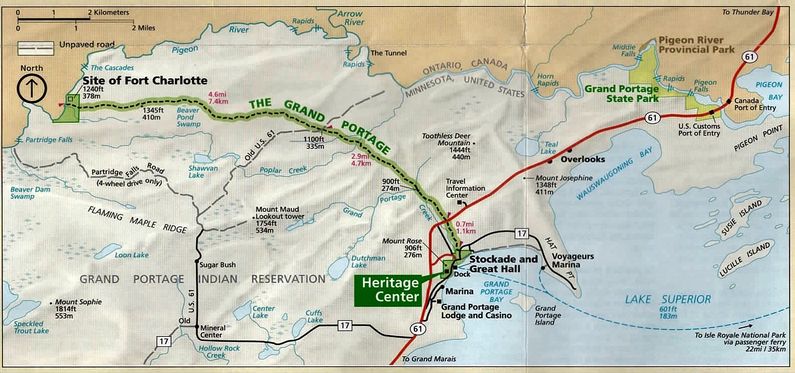 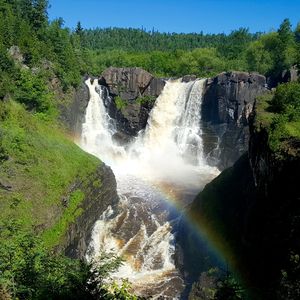 The Grand Portage itself was a difficult 8.5‑mile land route from the Grand Portage Post on the shore of Lake Superior to the inland Fort Charlotte. The route bypassed a series of rapids and falls along the Pigeon River that were too difficult to portage individually. The Grand Portage trail rises from the 600' level at Lake Superior to the 1,260' level where it meets the Pigeon River at Fort Charlotte. The Grand Portage had been in use for many years before the establishment of the NWC post and was identified by the French explorer Pierre Gaultier de Varennes, Sieur de La Vérendrye in 1731 as a known trade route.
Voyageurs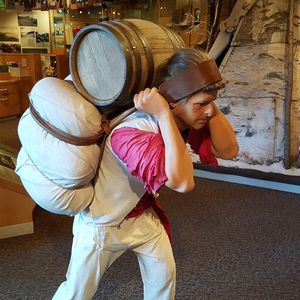 Trade goods were brought from Montreal by Voyageurs in canoe brigades following the north coast of Lake Superior to the Grand Portage Post. The trade goods were then portaged 8.5 miles around the rapids and falls of the lower Pigeon River to Fort Charlotte where the journey into interior Canada resumed by water. The trade goods were distributed among the trading outposts where they were exchanged for furs and the furs were returned to the Grand Portage Post. The furs were compressed into 90‑pound bundles and returned to Montreal in the same canoe brigades that brought in the trade goods. The Montreal canoes were up to 36' long and 6' wide and could hold 4 tons (8,000 pounds) of furs or merchandise. The 1,500‑mile trip between Montreal and the Grand Portage Post took six to eight weeks. Trading at the post took place in the July and August when trappers, traders, and Voyageurs gathered for a yearly rendezvous. As the winter approached the majority of the post's inhabitants left the post for warmer climates or larger cities. A few people wintered in the post. Life at the post resumed in the spring when the ice broke and the Voyageur canoes brigades returned.
The Post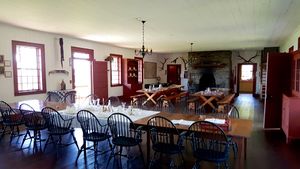 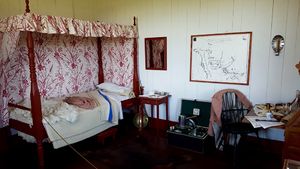 The post was described by Alexander Mackenzie during a summer visit as: "Beneath an hill ... is the fort, picketed in with cedar palisadoes, and inclosing houses built of wood and covered with shingles. They are calculated for every convenience of trade, as well as to accommodate the proprietors and clerks during their short residence there." There were sixteen wooden buildings inside the palisade, including the great hall, business office, six warehouses for trade goods, a kitchen and furs, and living quarters for the partners and clerks. A Wharf was provided for loading and unloading the vessels. The gates were locked after sunset and two sentries kept a lookout during the night. In 1793, the post processed some 182,000 beaver pelts, and eventually, almost the entire annual yield of the North West Company passed through this post.
Closure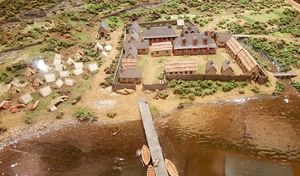 The North West Company success at the Grand Portage was not without conflict as the new United States Government struggled to establish its northern border. The Grand Portage Post actually fell on the American side of the border as defined by the Pigeon River at this point. In July 1802, the partners of the North West Company met in the grand hall of Grand Portage Post and voted to move it north to the mouth of the Kaministiquia River. The company tore down the post at Grand Portage and transported the materials to the new post at the mouth of the Kaministiquia River, initially named Fort Kaministiquia and later renamed Fort William.
Current StatusReconstructed post with a complete palisade, three reconstructed buildings, and a reconstructed main gate lookout tower. Outside the palisade are a replica of an Ojibwe camp and a Voyageurs camp. Entrance is through a visitor center and then along a short trail to the stockade. Just outside the palisade is the canoe building where replica canoes are on display. The two internal buildings are the great hall and the kitchen, both furnished with period furniture. Two trails start across the road from the palisade. One trail is a short hike up Rose Mountain and provides an overview of the site. The second trail is more arduous and follows the 8.5 mile path of the Grand Portage to the site of Fort Charlotte. There is nothing left of Fort Charlotte and a small stone cairn marks the site.
See Also: Sources:
Links:
Visited: 16 Jul 2016
| ||||||
